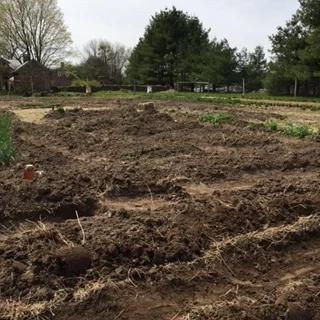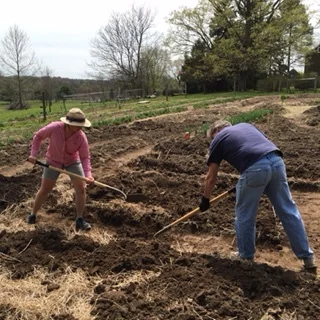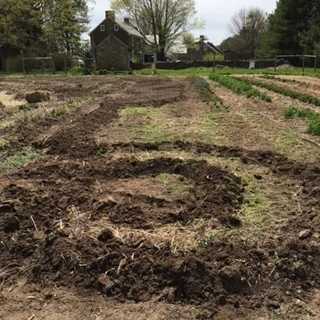Perennial Life.
The perfect Sunday afternoon...
It was a weeding day. Actually, it was mother's day. But after two weeks of rain & gray (read: two weeks of weeds* flourishing while it was too wet to remove them) I was eager to get out into the fields on this first day of bright sun and gusty breezes. So, after returning from brunch with my family, I put my productive-pants on, grabbed my shuffle hoe, and set to it.
For the record, this is not an instance of me being a workaholic. I've had many such instances in the past, and I am being very intentional this year about having a healthy amount of days off, reasonable bed times, novel reading, and generalized lounging. And Sunday is a day off.
It's not that I was feeling stressed about the emerging weeds* in the field; I was just so excited to start weeding them.
The J-Dude joined me when he saw how much fun I was having.
Shuffle hoeing and hand weeding are my favorite farm activities. If my job as a farmer meant that I spent more of my time weeding and less time doing all the other onerous activities such as planting, harvesting, marketing, inhaling the entrancing aromas, etc. then I would love my job even more and engage in existential angst even less. Alas, there are other necessary parts of the "herb production" equation; but I will insist that spending a glorious afternoon outside with my shuffle hoe (and in this case, my boyfriend!) is a most happy situation for me.
We focused our hoeing attentions on our upper field, also known as Clara's Garden. Last year this field had been primarily annuals in the center with some beds of perennials on each end. We completely reshaped the middle area of annuals: it went from being entirely straight beds (hearkening back to my days as a veggie farmer) to being a beautiful labyrinth with an altar at the center (reaching forward to many rituals and celebrations among the herbs).
Labyrinth design made possible by the skill & intuition of the J-Dude.
While bed-forming and weeding in this field of former annuals, we encountered a new phenomenon, rarely heard of in the vegetable world: the self-seeding annual.
Some herbs are annuals. They don't survive the winter, and they don't return. Others are perennials. I was so thrilled this year to watch our perennials come back, thriving, with little-to-no-help from their human caretakers. As a second-year herb farmer, this was a new experience for me. I was excited for it; I was expecting it.
I was not, however, expecting the emergence of this whole new group of self-seeding annuals.
German Chamomile self-seeded vigorously. We let a large portion of it stay in its bed from last year, transplanted some to a bed near the altar, and didn't save the rest.
This was a group of herbs that I expected to die and not return. Because that's the way I'm used to annuals behaving. Instead, some annuals produced seeds, which over-wintered in the soil and sprang up this spring, independent of potting soil, greenhouses, or irrigation (among them: German chamomile, tansy, sweet annie, anise hyssop, western mugwort, and silver sagebrush). Some came back vigorously in the exact same spot. Others spread their seed all over the field, to emerge as thousands of baby seedlings.
The self-seeding annuals posed a new quandary: on the one hand, what a gift! Look at all the plants we didn't have to seed and transplant and tend! On the other, hoe-wielding hand, these free-radical herb seedlings are looking an awful lot like weeds*.
What to do?
Can you see all those little purpley baby anise hyssop seedlings, growing just in front of the second-year, wise & mature anise hyssop plants? How much anise hyssop can we possibly use?
I love this quandary because it is an epitome of the difference between farming vegetables and farming herbs: herbs are wild plants, with their own agendas and strategies. We're doing our best to guide them to grow in certain ways so that we can have a profitable farm and spend our days shuffle hoeing, but we are also eagerly embracing the wildness of our botanical co-conspirators.
In the end, we did what any curious, not-yet-jaded young herb farmers would do: we removed the weeds*/herb seedlings that were growing in places where they absolutely needed not to be growing (e.g. around the base of all the marshmallow plants); we transplanted some to more convenient locations; and some we left right where they were, as an experiment. What will happen to this lush patch of tansy seedlings if we don't thin them out? How will they compete with each other and the weeds*?
See all that green? That is ALL TANSY. What's gonna happen?
We don't know what will become of our self-seeded annuals. We're not stressing. When the sun began to set, we headed inside to open a beer, reheat some leftovers, and chill on the couch. It was a Sunday, after all.
*weed: This is a highly controversial word in the herbalism community. Many of our most precious herbs (dandelion, nettle, mugwort, cleavers, poke, violet, chickweed, burdock, and countless others) are disparaged as "weeds" by many, and thus a violent war of herbicides is waged against them. We, herbalists, do not appreciate this. As a farmer, I use the term "weed" to refer to any plant that is growing in a space which I would like to reserve for a different variety of plant. I would love to not exercise oligarichal control over the plant's residential decisions. But if I did not exert some control, then I would not be a farmer and would thus have to get an indoor job in an office building where they spray roundup on the dandelions that grow along the pathways. Some negotiating is ok with me.







